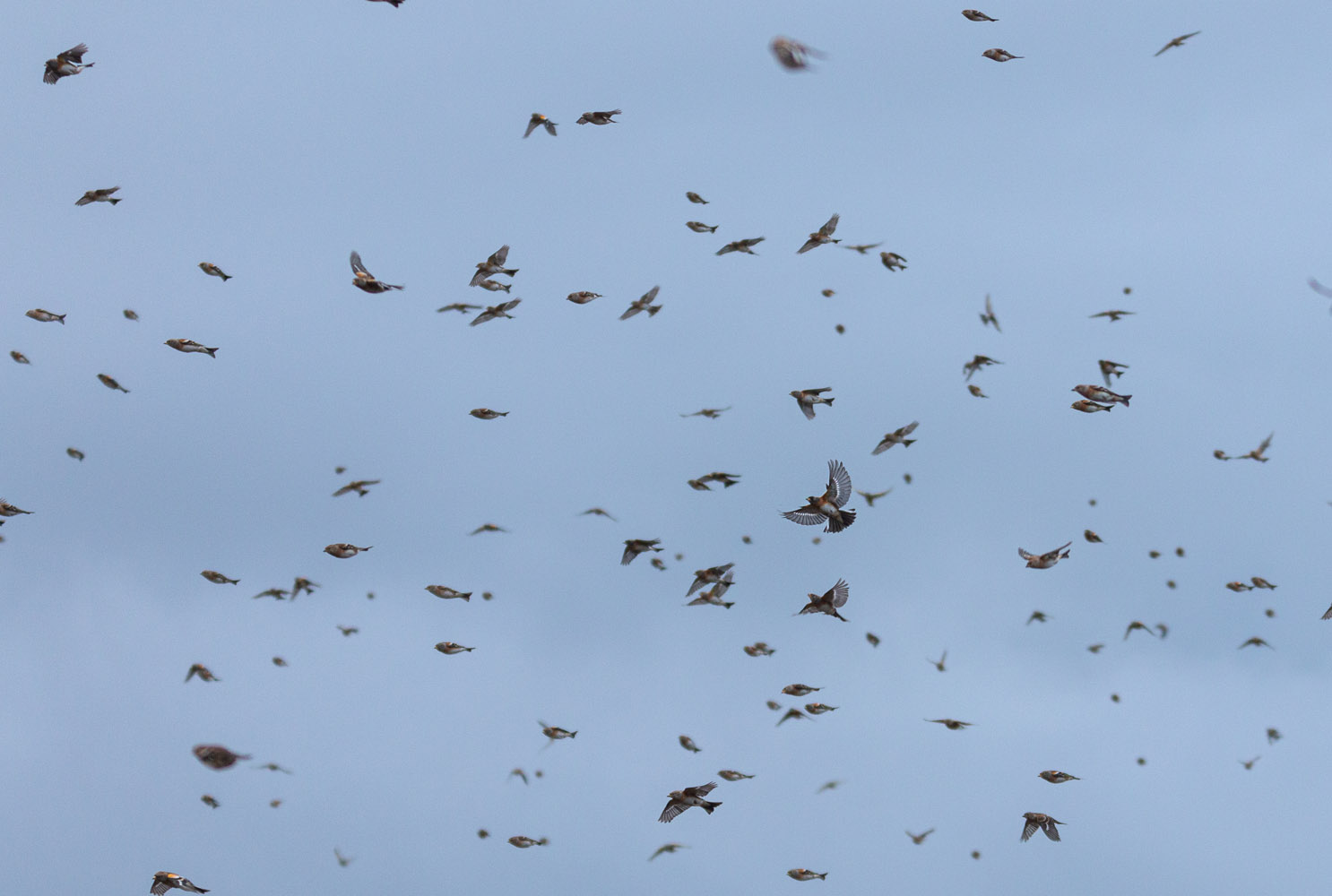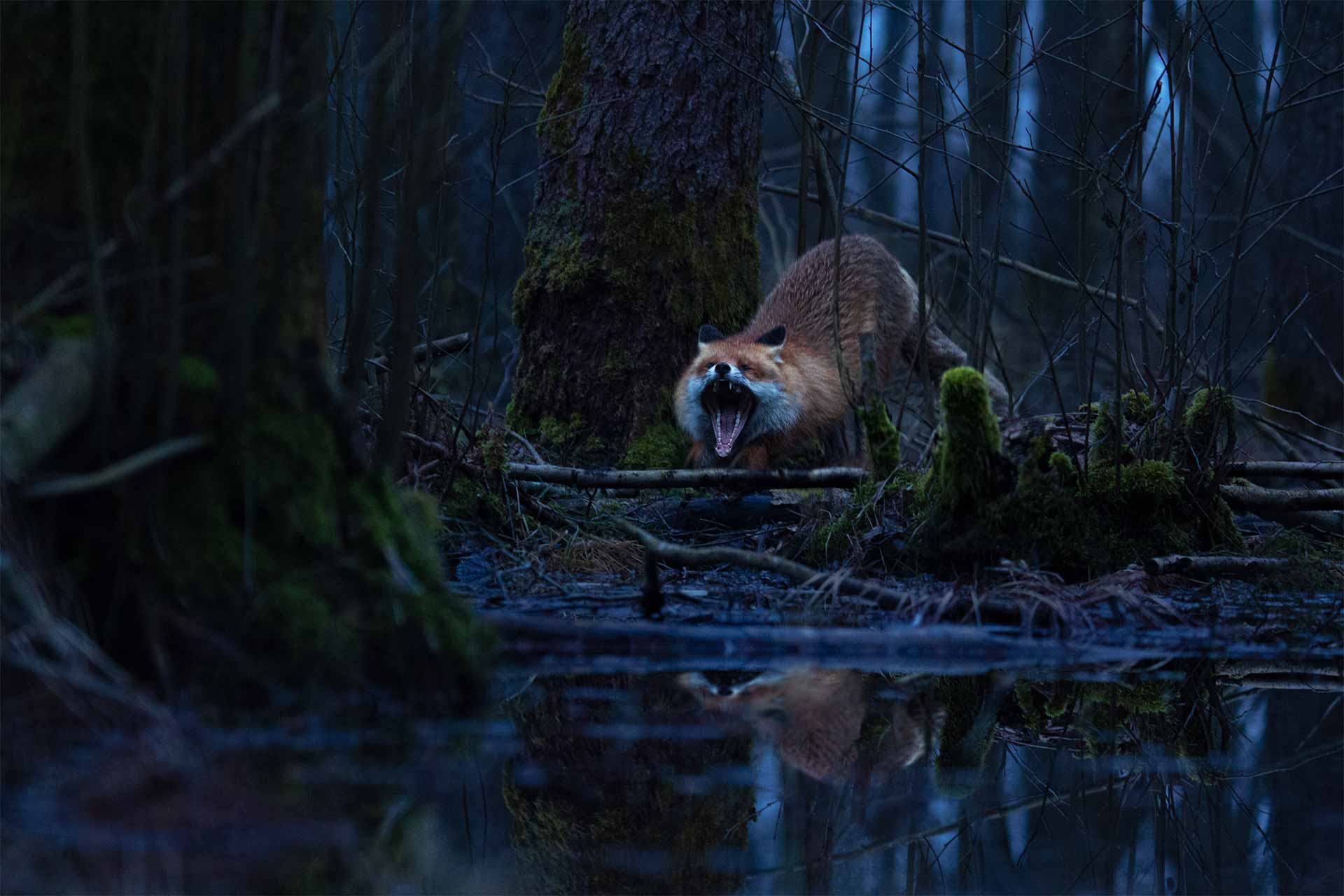Little Dreamer
Den lilla rävungen njöt av en tupplur bland stenar som värmts upp av morgonsolen. De lugna och intima stunderna i rävens liv är några av de vackraste. Jag närmade mig långsamt för att inte väcka räven och använde grönskan för att skapa en naturlig inramning. Med ögonen stängda vilade den unga räven bekvämt på sin “soffa” av solbelysta stenar, djupt inne i sina drömmar. Ungen vilade i över fyrtio minuter och bytte sovposition hela tiden.
ISO-2000, 1/400 sek, f/5.6 vid 273mm med stativ
Skåne, Sweden
5:55 PM, 14 Mars, 2024.


The following day I arrived at the field early in the morning – this time with a wide angle lens and a radio-controlled trigger. The plan was theoretically simple – set up the camouflaged camera in the snow, move away and hope that bramblings would come. The problem was that the field was huge and the birds had a very large feeding area to choose from. Most of the sunflowers were straight and tall, some of the flowers tilted, and others were broken in a way that their heads touched the ground. Birds preferred to feed on these unbroken, tall flowers, as the seeds were more easily accessible there. They also had a good view of the whole area from above and could react faster in case of a falcon attack. Some of the birds also foraged at the bottom, eating the seeds that fell on the snow.
There were more broken sunflowers in one part of the field, and some of them were almost touching the ground. Additionally, there were lots of tracks and scattered seeds in the snow. That was a very good sign. I decided to set up my camera at that spot. This time I had a 10mm wide-angle lens and a mirrorless camera with an electronic shutter, which is especially important when shooting at close distances because it is silent and does not scare animals. I chose a composition, masked the camera with snow and dried sunflowers. I chose the aperture of f/22 to keep the foreground and background in the depth of field. I set the focus point manually at about 20cm from the lens. Then, I connected the radio-controlled trigger with its range of about 50m. Finally, I move away to a safe distance and wait patiently for the events to unfold.
Time was passing by but the birds were still absent. I started to ponder over the sense of my plan, doubting whether the birds would choose this small fragment of field, where I had my camera, out of the enormous area full of sunflowers. At one point I saw a peregrine falcon in the sky. It was a good sign, because its presence always causes a commotion in the area, and then bramblings change their place. How happy I was, when after a while a whole flock of finches flew to the area where I had my camera hidden! The birds were just a few meters away. Promisingly close, but still not enough to take the dreamed photo, as the ideal distance was about 10cm from the lens. Only then the birds would be big enough in the frame to nicely fill the composition. The situation was complicated by one more problem – I had no live view from the camera’s viewfinder, and therefore no idea what the current composition in the camera looked like. I could only guess it, based on what I saw through the binoculars, hidden few dozen meters away. I waited patiently for the development of events. Within minutes, the camera was surrounded by birds. I could not believe it! I was releasing the RC trigger again and again, as everything seemed to indicate that bramblings were in the exact spot I had planned. At one point, I saw through my binoculars that one of the bramblings landed right in front of my camera and decided to husk the sunflower seeds… in the lens hood!


Always, when working on a subject, I strongly encourage you not to finish after one day of photography, even if you already have taken many great photos on that day. I know from experience that after spending more time in one place, you start to look at it from a different perspective and begin to see opportunities for even more interesting and creative photos.
That’s why I love working locally. It allows me to visit the area more often and get to know the animals that live there. And it doesn’t matter to me whether I am photographing a rare owl or a common sparrow. I think that every animal is special in some way and is worth photographing. Sometimes you just need to spend more time with it to see its beauty. The idea for an interesting frame will come by itself. The only thing left to do is to press the shutter button and take that one, unique photograph.

